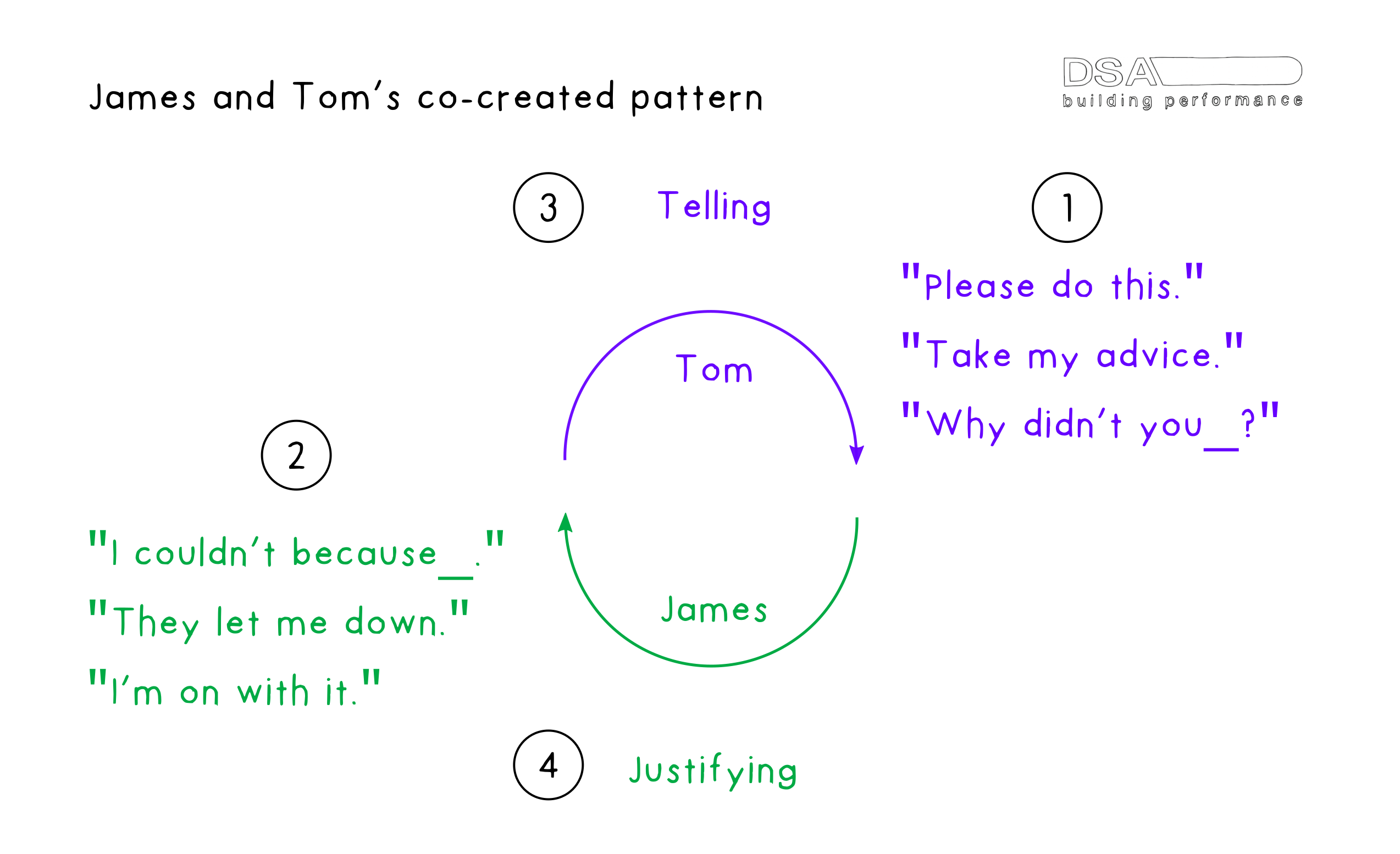
Coaching can help someone think afresh
Co-created patterns are situations in which two people become paired up in mutually reinforcing behaviour. Sometimes the co-created patterns are effective, leading to positive outcomes, and sometimes they are ineffective, leading to negative outcomes.
As the fictional scenario here shows, coaching can help someone think afresh about how to shift ineffective co-created patterns. In this dialogue I am coaching James, who wants to break out of an ineffective co-created pattern with his boss, Tom.
“Hi James, what do we need to think about today?”
“Hi Dave. Well, things aren’t working between me and my boss, Tom. It’s like we are going around in circles. I’d like to explore what’s going on and how I can get him to treat me better.”
“Okay, given we have just under half an hour, what would be a good outcome for you here?”
“A good outcome would be me seeing what’s going on, and having a few new ideas to move it forward.”
“How will you know you are getting what you need here?”
“Maybe I will see the relationship in a new light. And I definitely need new ideas because I have tried a lot in the last six weeks with him and don’t seem to be getting anywhere.”
“And how are we going to do this, you and I?”
“Well I am going to think and talk and I’d like you to listen, Dave, and tell me what you notice. I don’t want you to give me advice because I know that’s not coaching and I find it irritating when people tell me what to do based on their world, which is different to mine.”
“Where would you like to start?”
“Can I talk about how Tom addresses me? He just has a knack of putting me on the back foot.”
“Go on then.”
“Well, he’s always telling me what to do. He’s polite and says please but I know it’s an instruction and half the time I don’t think it’s the best way forward or even the right thing to do, but I don’t seem to have any say in it.”
“What else?”
“He gets frustrated with me and says, ‘James for goodness sake take my advice here’.”
“And?”
“He says, ‘Why didn’t you do that and why didn’t you do what I suggested?’”
“I’m noticing you’re making notes.”
“Yes, I have bulleted what Tom normally says to me.” (See three bullets, item 1, in the diagram)
“What about what you typically say to him?”
“Gosh, I can hear myself. Hang on Dave, let me write this down as well, this is interesting.” (James captures three bullets, item 2 in the diagram). “Basically, he is telling (3 in the diagram) and I am justifying (4 in the diagram).”
“What do you make of that?”
“That’s it! We’re going round in circles. The more I justify the more he tells, and the more he tells the more I justify, and round we go. I can see it now. Let me draw it here Dave.” (James draws in arrows in diagram with Telling above Tom’s arrow and Justifying below his own arrow).
“And?”
“It’s just going to go on, isn’t it? This is what is happening. It’s not Tom, it’s both of us. We are doing this together.”
“How are we doing here, James?”
“This is great, I’ve never seen it like this before, and now I’ve drawn it out, it’s as clear as day.”
“We have ten minutes, what would be most useful for you here and now?”
“What needs to happen to shift this dynamic, Dave?”
“What do you think?”
“Uh, right, back to me. Well, I think Tom needs to stop telling me; that would work.”
“Tom is not here?”
“What do you mean?” (James looks up towards the ceiling and falls silent, I hold the silence). “Dave, he can’t see it, he’s not here. He can’t see what I can now see. It’s back to me, isn’t it. I have to make the first move here don’t I?”
“What’s your move?”
“What if I start making suggestions and let Tom know where I’m up to before he asks? And what if I identify the support I need from him and ask him?”
“What would you call that?”
“Proactive.”
“How are we doing here, James?”
“Great, I can see what has been going on and I am going to shift my approach and see what happens. This could work. Me being proactive could shift the dynamic with Tom.”
“We have a few minutes, so what’s the best way you and I can finish this session together?”
“Well, I’d like to say thanks, Dave. This could be a fork in the road for me with Tom, and in my career here.”
“Thanks, James, it’s been a pleasure.”
Reflections
Leadership Team Coach Dave Stitt works with construction industry executives and project teams enabling them to deliver remarkable results in a remarkable way.
Dave is the creator of Coach for Results, an accessible online course teaching the basics of a coaching management style so managers can grow confidence, capability and enthusiasm in the people around them.
Read more blogs from Dave – ‘Coaching management style relieves pressure on younger managers’. HR Director

+ 3 more
48 years experience in construction industry, last 24 as leadership team coach